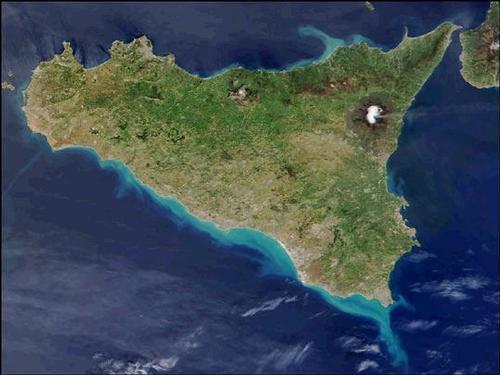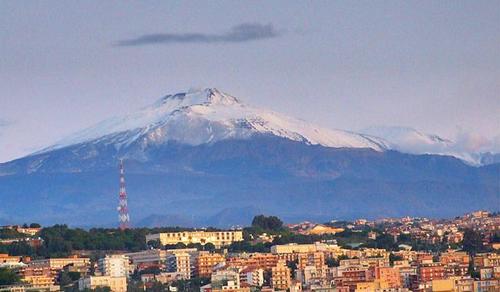SICILY


Popular destinations ITALY
| Campania | Lombardy | Sardinia |
| Sicily | Tuscany | Umbria |
| Veneto |
Geography and Landscape
Geography
Sicily (Sicilian and Italian: Sicilia) is an Italian island in the Mediterranean Sea and is separated from the Italian mainland (Calabria) by the three kilometre wide Strait of Messina (Stretto di Messina). Together with the Aeolian or Liparian Islands, the Egadi archipelago and some other islands, the island forms the "regione" of the same name and has a surface area of 25,708 km2, which makes it the largest island in the Mediterranean Sea.

It is also the largest "regione" (area) in Italy. North of the island is the Tyrrhenian Sea, east the Ionian Sea and south and west the Mediterranean. Tunisia (Cap Bon) is only 150 kilometres south of Sicily. Sicily is at the same altitude as Southern Greece, Northern Tunisia and Southern Spain.
Landscape
The island is a continuation of the Apennine Peninsula both geologically and physico-geographically and is therefore not really an island. Sicily can be divided into five landscape units:
The coast of Sicily is 1030 kilometres long and only on the broad southern cliff coast do you find long sandy beaches. The Tyrrhenian and Ionian coasts in the east are narrow and mostly steep. There are many bays between the mountains and rocks that run down to the sea.
Eastern Sicily is dominated by the imposing volcano Etna and the surrounding Etna massif. Etna is the largest active volcano in Europe and one of the largest in the world. The volcano has a height of 3340 metres, making it the highest point in Sicily. The volcanic soil around Etna is naturally very fertile. The 590 km2 Etna massif is a national park. At least 80 eruptions are known from Etna and the last life-threatening activity of the volcano dates back to July 2001.
 Etna, Europe's largest active volcano and Sicily's highest pointPhoto: Gnuckx CC 2.0 Generic no changes made
Etna, Europe's largest active volcano and Sicily's highest pointPhoto: Gnuckx CC 2.0 Generic no changes made
Earthquakes and landslides have also caused damage over the centuries. In 1908, for example, Messina was completely destroyed and in 1968, 600 people died and 150,000 were made homeless. Due to volcanic activity, Sicily also has many mud and hot water springs (fumaroles).
The interior of Sicily is hilly with in many places remarkable stone masses on which even cities and villages are built. The soil consists of fertile clay. Furthermore, there are a few scattered mountain ranges in the inland that do not rise above 1000 metres.
In the southeast lies the dry and limestone Ragusa plateau. The plateau is intersected by green, fertile river valleys such as the Cava Grande and the Valle d'Anapo.
The Cyclic or Sicilian Apennines is an east-west chain of mountains in northern Sicily, consisting of the Monti Peloritani, Le Madonie (highest point: Pizza Carbonara, 1979 metres) and the Monti Nebrodi (highest point: 1847 metres). These sand and limestone mountain ranges are home to many species of flowers and plants. Like the Balkan mountains, the Pyrenees and the Alps, they belong to the Alpine mountain ranges that formed in the Tertiary period, between 2 and 70 million years ago.
The rivers, including the Torto, the Simeto and the Salso, are mostly dry in summer. In winter, however, they can cause serious flooding if the water levels are high. The best known natural lake is the Lake Pergusa, which also dries up in summer.
The island of Lampedusa is the southernmost tip of Italy and belongs together with Linosa and Lampione to the Pelagian Islands.
The Egadi Islands (Favignana, Lévanzo and Marettimo) located west of Sicily are remnants of the Northern Italian mountain range. The Aeolian or Liparian islands consist of Lípari, Salina, Vulcano (a working volcano), Alicudi, Filicudi, Panarea and Strómboli (also a working volcano). North of Palermo is the island of Ústica and southwest of Sicily is Pantellaria.
Sources
Scholten, J. / Sicilië: met de Egadische en Eolische eilanden
Van Reemst
Bausenhardt, H. / Sicilië
Van Reemst
Haan-van de Wiel, W.H. de / Sicilië
Gottmer
CIA - World Factbook
BBC - Country Profiles
Copyright: Team The World of Info